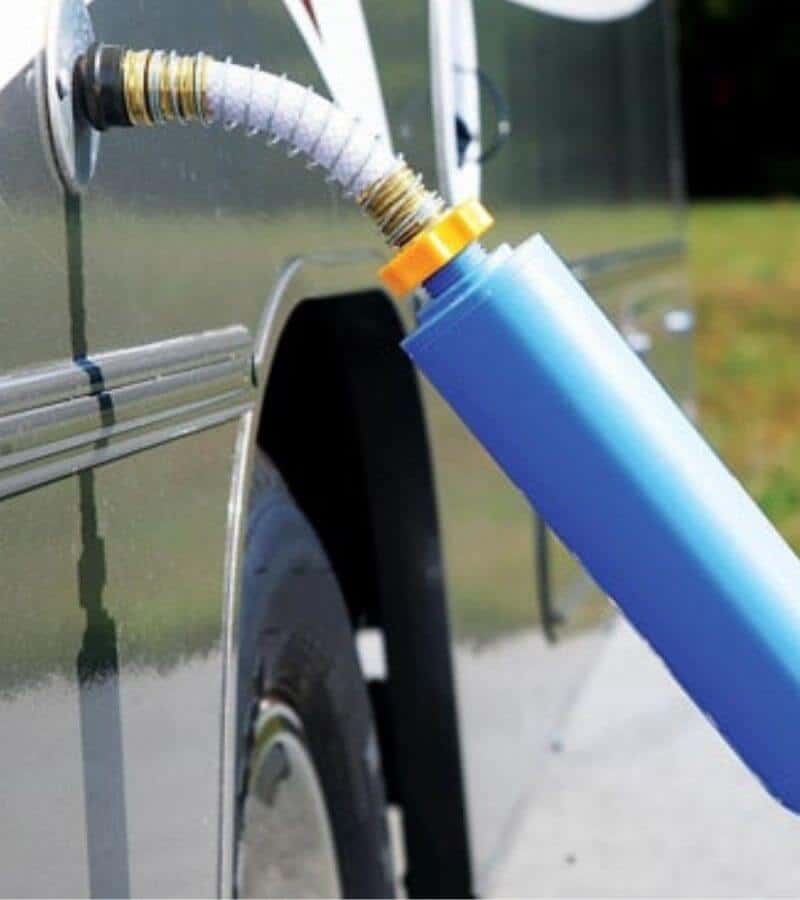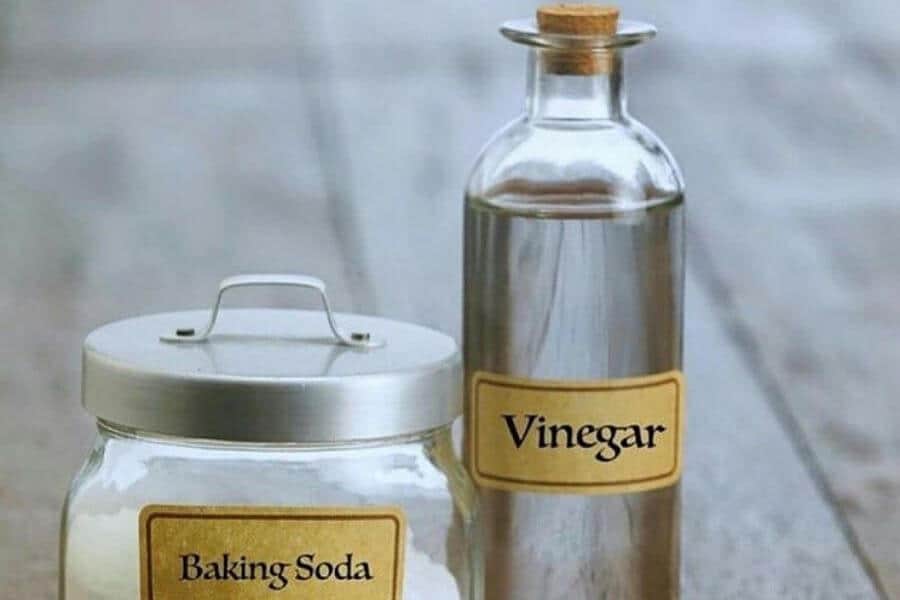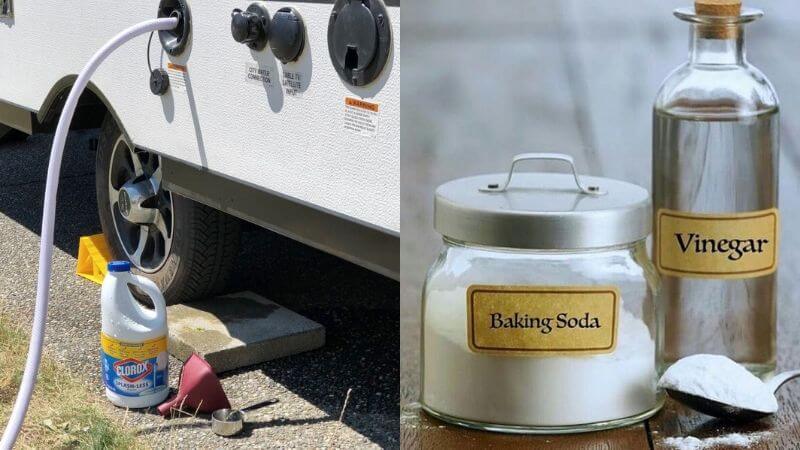A clean freshwater system on your RV plays a very important in enjoying your vacation. Of course, safety paramount.
So, it’s wise to take some basic precautions. Can bleach be used to safely clean your RV’s freshwater system? Is it possible to sanitize your freshwater tank without bleach?
To properly answer these questions, we are going to need to take a close look at the little details that make a big difference.
The last thing you want to do is play fast and loose with the water your family will use to wash and clean with.
Some of the more common substances you can use to sanitize your RV freshwater tank includes:
- Bleach-free cleaning solution
- Vinegar
- Baking soda
In this article, we will take a closer look at the various ways you can safely sanitize your RV’s freshwater system without using bleach. This includes a deeper understanding of how the system works.
How Does Freshwater Sanitation Work?
The contents of your freshwater tank will be used to wash the dishes you eat with, flush your RV toilet, and provide the water your family will bathe in.
Getting a better understanding of your water system will go a long way toward making sure that your family’s water usage is safe.
There are some substances which can be harmful or may cause unnecessary complication.
There are some that are just a plain old “Bad Idea” and you should consider alternatives.
Is It Safe To Sanitize Your RV Water Tank With Vinegar?
I think it’s best to get a better understanding of the effects of bleach before we dig into the nuts and bolts of the water system.
You see when water sits in pipes or plastic water lines for a long period of time, it can start to become contaminated with pathogens.
Even a miniscule population of bacteria and other microbes can multiple in pipes and tanks that aren’t properly sanitized.
Most municipally provided sources of water are treated with chlorine or bleach before they are supplied for human consumption. This is ideal for supplying your freshwater tank.
Most water treatment plants use a low-concentration of chlorine around 4 parts per million or (ppm). This is considered to safe and largely flavorless.
When you attempt to treat your own freshwater tanks with bleach, you risk over-concentration, which can have disastrous medical complications, and potential plumbing problems.
In fact, there are some people who are already concerned about the chlorine content of their drinking water, let alone the possible impact of accidentally ingesting too much.
What Are Other Ways To Sanitize An RV’s Freshwater System
Fortunately, RV product manufacturers are aware of the concerns about bleach and the need to provide safe water to your family.
This means there are several options to consider. Some can be bought online, while others you can handle on your own. It includes store-bought items like vinegar and baking soda.
Make Sure To Flush Your RV Water System And Empty It When It’s Not In Use
Part of properly maintaining your RV’s water system is to drain and flush it when not in use. This helps to deprive bacteria and other microbes of the moisture they need to reproduce.
Yet it’s also worth bearing in mind that there are many types of bacteria that can preserve themselves as spores when forced to deal with dry conditions.
So, you shouldn’t assume that just because the water system is dry, that there are no bacteria present.
At the same time, draining the freshwater system also reduces the chances of calcium building up in water lines and storage tanks.
What’s The Best Source Of Water For My RV’s Freshwater Tank?
Water from a municipal source is superior to other water sources. It means that the water has been treated and tested to meet human safety standards.
This makes city water a wiser choice than well water.
In some instances, flavor or odor is also a factor. While your garden hose might be the easiest method for filling the freshwater tank, many people complain that it imparts a rubbery essence to the water it delivers.
If possible, you should be able to find a dedicated water line with the proper connections to attach to a kitchen sink.
Yes, it will take a little longer to fill, but I think you’ll find the water it provides to smell cleaner.
While many RV travelers will drink the water from their freshwater tank, I personally prefer to use a separate “Aquatainer” or one-gallon jugs for the water I want to drink and cook with.
If I’m going to boil pasta, I’ll use the freshwater tank’s reserves. If the water isn’t going to be boiled, then I’ll turn to stored jugs.
How Often Should I Sanitize My RV Water Tank?
There is no hard and fast rule to answer this question. Yet this is still the sort of thing you shouldn’t take lightly.
I would personally recommend thoroughly sanitizing it before any long trip. It’s also a good idea to sanitize it again if the RV has sat idle for more than three months.
Of course, it’s always a good idea to add freshwater sanitation to your list of spring tasks, when you take the RV out of winter storage.
Best Ways To Sanitize My RV’s Freshwater System without bleach?
While draining your freshwater tank when not in use is certainly a wise idea, there are also times when it needs a deeper clean.
As time goes on, even a miniscule population of bacteria in your freshwater tank can impart foul odors and raise concerns about the cleanliness of the water you rely on while traveling.
The following are some of the more popular and “Safe” options for sanitizing an RV’s freshwater system.
1: Commercial RV Water Sanitation Products
RV product manufacturers are aware of the need for clean freshwater, and many offer their own take on how to safely clean your tank.
The number of available options can be staggering when you first go shopping for them online or in the store.

The CamcoTastePURE Water System Cleaner and Deodorizer have become one of the more popular options among RV travelers.
Not only is it bleach-free, but it also manages to effectively sanitize the system while eliminating foul odors and the annoying plastic odorthat you get from many of its competitors.
Just keep in mind that CamcoTastePURE isn’t intended to be a water additive. It’s meant to effectively cleanse the system and rinse the water lines before you refill the freshwater tank again.
If you are in a pinch, and you need to sanitize the tank, your best option is still chlorine bleach.
You just need to take care to use low concentrations, so that your family isn’t consuming the bleach.
2: Sanitize RV’s Water System With Vinegar
Vinegar, or acetic acid, can also be a very effective alternative to bleach when it comes to cleaning and sanitizing your RV’s freshwater systems.
The acid content of simple “White Distilled Vinegar” is technically high enough to kill most harmful bacteria and microbes that may establish a presence in your RV water system.
This means it can disinfect while also helping to clear away excess calcium buildup.
However, some people don’t like to use vinegar for this, as it can impart a very strong odor and flavor to the water.
When you get it wrong, you can feel like you are taking a shower in diluted pickle juice.
Step By Step Instructions For Using Vinegar To Sanitize RV Water Tanks

3: Sanitize RV’s Water System With Baking Soda
On the other end of the spectrum, baking soda also does a good job of deodorizing and reducing buildup in your RV water system.
Unfortunately, it’s not as effective at sanitizing and killing bacteria.
Some people like to use vinegar to kill bacteria, and then neutralize it with a follow-up cleansing with baking soda.
Step By Step Instructions For Cleaning An RV Water System With Baking Soda
Make Sure To Sanitize Your Water System Before Winterizing
There are many important steps in the winterizing process, which includes emptying, purging and sanitizing your RV’s water system.
Using a commercial water tank sanitizing product, or doing a vinegar cleanse, followed by a baking soda cleanse, will go a long way toward killing any bacteria that might exploit the warmer days of late fall and early spring to colonize your water system.
It also helps to combat calcium and lime buildup at the end of a long summer of adventuring.







![Our Review of The 8 Best RV Vacuums in [currentyear] and Why 6 Best RV Vacuum](https://www.rvingknowhow.com/wp-content/uploads/2020/06/Best-RV-Vacuum.jpg)
5 Comments
Roger Thompson
4 years agoSo, with the vinegar method, you’d need 39 gallons of vinegar for a 78 gallon freshwater system?
Then with the baking soda method all you need to do is make a one-gallon solution, slosh it around for a while in the system, then drain the system? Seems like not enough baking soda, even though your site and another one both say basically the same thing.
Aaron Richardson
4 years agoWe have used baking soda to our fresh water tank after sanitizing the tank with vinegar. Simply add about a cup of baking soda to a few litres of fresh water in a bucket and pour it into the water tank, which should be only half full at a maximum.
This will neutralize the vinegar and sweeten the taste of water that sometimes is not as you would like it to be.
marge
3 years agoNot sure I understand, we have a 40 gallon tank in our small motor home and I hate the taste, I think it is the bleach. If I add the baking soda, do I let sit over night and drain then refill with my water? Thanks!
Aaron Richardson
3 years agoLet it sit for about an hour.
Johnny Rutledge
4 years agoAccording to my interpretation of the instructions, you’d need 19.5 gallons of vinegar for a 78 gallon fresh water tank . It says to use a 1:1 ratio of vinegar to water and fill your tank approximately 1/2 full with the solution. That would mean 39 gallons of the solution of vinegar and water in total (19.5 gal of vinegar + 19.5 gal of water). That’s how I understood it anyway.